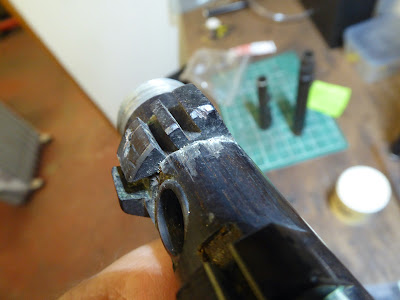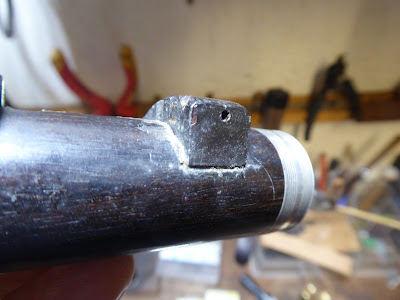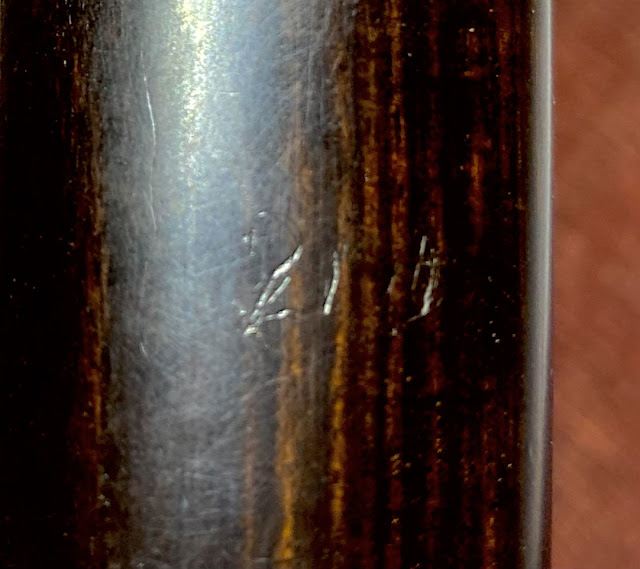Wylde is one of those names that constantly appears in any discussion of the English simple system flute in the 19th century.
I think it's important to realise that many of the great "flute makers" of the period never in fact made flutes. The common pattern was for a professional flautist who was engaged in teaching - most of them were - to team up with a flute maker, to provide flutes initially to their pupils, and to the general public.
Rudall & Rose are probably the best known example of this. As detailed in a previous blog, George Rudall initially worked with John Willis, and those instruments, made just either side of 1820, were stamped G. Rudall, and the only acknowledgement of the actual maker was a small WILLIS FECIT (latin for Willis made it) on the foot. Although Rose, after he went into partnership with Rudall in 1821 in all probability made some of the earlier instruments, I suspect it's more likely that his role was increasingly as a workshop supervisor, managing the production of flutes by a group of workers at different skill levels.
We see a very similar pattern with names such as Sicama, Pratten and Nicholson in England, and Tulou in continental Europe, where these performers either had flutes made to take advantage of their popularity, or were approached by established makers who wanted to associate their wares with those of famous performers.
Wylde belongs to one of a group of makers who although they did trade under their own names, produced many more flutes for others than under their own marque.
The flute I'm showcasing here is one of Wylde's so let's look at it in detail.
Ostensibly a standard enough cocus and silver 8 keyed flute, a closer examination shows some details that indicate that it's a cut above the standard. The address, 15 Newington Causeway indicates a date of 1835-36, or possibly 1832-38, but certainly the 1830s.
Firstly the wood, cocus, is a suberb example of the best quality timber, with straight even grain, and a wonderful richness and depth of colour - although this last is partly due to the finish.
All three tenons are supported at the tip and base by silver rings.
The design and working of the key slots and seatings, again shows great attention to detail. The key slots are lined, and the double spring (of blued steel) is neatly incorporated by riveting on to an extension of the liner.
The pad seatings are beautifully executed in doughnut form, which as you can see in the image above, makes an efficient impression on the pad. Note also the neatness of the spring rivet, and the profiling of the spring itself.
The screw mechanism has an ivory screw through a silver sheathed crown.
Ivory screws are commonly found on good quality flutes, even where ivory is not otherwise used. I've come to the conclusion that the reason behind this is that forming threads both external and internal, with the types of woods used in flute making is not an easy task, as the fine points of the thread tend to shear off, resulting in a "blunt" thread, which is not very functional for fine adjustments. Using ivory, on the other hand, results in a strong well formed thread which is very durable.
An unusual feature is the number stamp, which only appears on the foot, and which I read as 508.
The flute came to me in fairly good condition. There was the almost standard crack in the head, conveniently in this case, not through the embouchure.
The main problem was the severely damaged block on the foot, holding the Eb key, and the C and C# touches.
Looking from below, it doesn't look too bad...
But from this angle, you can see that the block has been replaced...and badly!

So badly in fact, that there has been no attempt to provide a side to the Eb slot. Look at the angle above, where you can see that the flat bottom of the block replacement simply sticks out as far as the original edge of the slot.
This didn't become obvious until the Eb key was removed.
So the block had to be replaced, and in doing this it became obvious why the replacement block didn't have a proper side to it. As you can see in the pic below, milling out enough material to allow a block replacement going across far enough to make a proper Eb slot means the base of the slot going through the bore of the socket.
This makes the job a little more complicated, as profiling the block to fit the socket bore couldn't be done until the block was glued in place.
The other issue with this replacement block was that of course the slots were unlined, which they were on all the other blocks, and certainly were on the original. So this meant making new liners, milling the slots wide enough to take them, and gluing them in place.
Just a note here about the whole concept of lined blocks. They become reasonably common in the late 18th century, contemporaneous with the appearance of multi keyed flutes. I can't think that I've ever seen it on a one keyed flute, but not saying that it doesn't exist. Many think that the purpose of the lining was simply to make the action of the key smoother by operating between metal as opposed to wooden sides in the slot. I don't believe that this is the case. My idea is that the real purpose was to prevent the block splitting at the level of the axle/pin hole, as the block liner would take all the pressure, as opposed to the wood. Evidence is that you never see a lined block that is split at that level.
Here's the new block replacement....
...and a view showing the block liners.
One other small detail of this flute I thought unusual. The number 210 is scratched on the head and the crown, but nowhere else on the flute.
All in all, a very nice flute.
The sounding length, at 596mm is on the long side for a flute of this period. Compare 586.5 for Prowse Nicholson Improved #3929 from approximately the same date, and much later Rudall Carte & Co. 7183 at 566mm. The embouchure measures 12.14 x 11.00, and head diameter at the embouchure is 27.5mm.
Special thanks to Simon Waters for information on the date of this flute.












